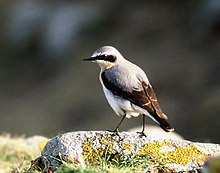Wheatear
| Wheatears | |
|---|---|

| |
| Male northern wheatear (Oenanthe oenanthe) | |
| Scientific classification | |
| Domain: | Eukaryota |
| Kingdom: | Animalia |
| Phylum: | Chordata |
| Class: | Aves |
| Order: | Passeriformes |
| Family: | Muscicapidae |
| Subfamily: | Saxicolinae |
| Genus: | Oenanthe Vieillot, 1816 |
| Type species | |
| Motacilla oenanthe[1] Linnaeus, 1758
| |
| Species | |
|
See text | |
| Synonyms | |
|
Cercomela | |
The wheatears
Taxonomy
The genus Oenanthe was introduced by the French ornithologist
The name "wheatear" is not derived from "wheat" or any sense of "ear", but is a folk etymology of "white" and "arse", referring to the prominent white rump found in most species.[8]
Description
Most species have characteristic black and white or red and white markings on their rumps or their long tails. Most species are strongly sexually dimorphic; only the male has the striking plumage patterns characteristic of the genus, though the females share the white or red rump patches.
Species list
The genus contains 33 species:[9]
- Northern wheatear, Oenanthe oenanthe
- Atlas wheatear, Oenanthe seebohmi[10]
- Capped wheatear, Oenanthe pileata
- Buff-breasted wheatear, Oenanthe bottae – formerly the red-breasted wheatear
- Rusty-breasted wheatear, Oenanthe frenata – split from O. bottae
- Heuglin's wheatear, Oenanthe heuglinii
- Isabelline wheatear, Oenanthe isabellina
- Hooded wheatear, Oenanthe monacha
- Desert wheatear, Oenanthe deserti
- Western black-eared wheatear, Oenanthe hispanica
- Eastern black-eared wheatear, Oenanthe melanoleuca
- Cyprus wheatear, Oenanthe cypriaca
- Pied wheatear, Oenanthe pleschanka
- White-fronted black chat, Oenanthe albifrons (formerly in either Pentholaea or Myrmecocichla)
- Somali wheatear, Oenanthe phillipsi
- Red-rumped wheatear, Oenanthe moesta
- Blackstart, Oenanthe melanura (formerly in Cercomela)
- Familiar chat, Oenanthe familiaris (formerly in Cercomela)
- Brown-tailed rock chat, Oenanthe scotocerca (formerly in Cercomela)
- Sombre rock chat, Oenanthe dubia (formerly in Cercomela)
- Brown rock chat, Oenanthe fusca (formerly in Cercomela)
- Variable wheatear, Oenanthe picata
- Black wheatear, Oenanthe leucura (type species)
- Abyssinian wheatear, Oenanthe lugubris
- White-crowned wheatear, Oenanthe leucopyga
- Hume's wheatear, Oenanthe albonigra
- Finsch's wheatear, Oenanthe finschii
- Maghreb wheatear, Oenanthe halophila[10]
- Mourning wheatear, Oenanthe lugens
- Basalt wheatear, Oenanthe warriae[10]
- Arabian wheatear, Oenanthe lugentoides
- Kurdish wheatear, Oenanthe xanthoprymna
- Red-tailed wheatear, Oenanthe chrysopygia
Behaviour
Wheatears are terrestrial insectivorous birds of open, often dry, country. They often nest in rock crevices or disused burrows. Northern species are long-distance migrants, wintering in Africa.
Fossil record
- Oenanthe kormosi (Late Miocene of Polgardi, Hungary) [11]
- Oenanthe pongraczi (Pliocene of Csarnota, Hungary) [11]
References
- ^ "Muscicapidae". aviansystematics.org. The Trust for Avian Systematics. Retrieved 15 July 2023.
- ^ Mayr, Ernst; Paynter, Raymond A. Jr, eds. (1960). Check-list of Birds of the World. Vol. 10. Cambridge, Massachusetts: Museum of Comparative Zoology. p. 121.
- ^ Vieillot, Louis Pierre (1883) [1816]. Saunders, Howard (ed.). Vieillot's Analyse d'une nouvelle ornithologie élémentaire (in French). London. p. 43.
{{cite book}}: CS1 maint: location missing publisher (link) - ^ PMID 19772925.
- PMID 22634240.
- .
- ISBN 978-1-4081-2501-4.
- ^ "Wheatear". Merriam Webster Online. Retrieved 13 May 2010.
- Rasmussen, Pamela, eds. (January 2023). "Chats, Old World flycatchers". IOC World Bird List Version 13.1. International Ornithologists' Union. Retrieved 7 February 2023.
- ^ a b c "Species Updates – IOC World Bird List". Retrieved 27 May 2021.
- ^ a b Kessler, E. 2013. Neogene songbirds (Aves, Passeriformes) from Hungary. – Hantkeniana, Budapest, 2013, 8: 37–149.
